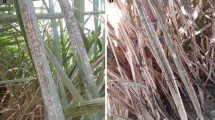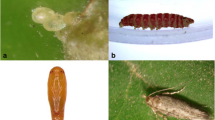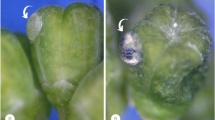Abstract
An outbreak of the sugarcane whitefly (Neomaskellia andropogonis Corbett) recently occurred in sugarcane fields in Khuzestan Province of Iran. This pest sucks plant sap producing large amounts of honeydew. In Khuzestan Province, populations of all developmental stages increase from early August until late November. At this time, when sugarcane is at the ripening stage, nymphs suck the sap, and in cases of severe infestation, retard the growth of sugarcane plants. In this study, we investigated the biology of the pest on different cultivars of sugarcane and under different temperatures. Also, we conducted experiments to determine the damage caused by the pest in the field. Mean pre-adult developmental times were 24.09, 28.06, 27.27 and 26.64 days on CP69–1062, CP57–1062, CP48–103 and NCO-310 cultivars, respectively, and only female progeny were produced. Mean longevity of females on the four cultivars was 6,8.49,4.15 and 4.60 days, respectively. Adult females laid an average of 61.80, 58.80, 41.10 and 39.38 eggs on the four cultivars, respectively. Results show that the optimum temperature for development of different stages of N. andropogonis is 30±1°C during the day and 25±1°C at night, and at this temperature, egg and nymphal duration (including first, second, third instars and pupae) and adult longevity were 6.2, 17.0 and 7.6 days, respectively. Females of cultivar CP69–1062 laid an average of 50.09 eggs. Analysis of data on the quality of damage (including Brix, pol and refined sugar factors) shows that damage was inversely and significantly correlated with the number of infested leaves. Whitefly damage differed among cultivars; and, based on the quality of damage, early maturing cultivars were more susceptible to whitefly damage. We collected two parasitoid wasps from nymphs—Encarsia inaron (Walker) (Hym.: Aphelinidae) and Eretmocerus delhiensis Mani (Hym.: Aphelinidae). To the best of our knowledge, this is the first study to assess the biology, damage and natural enemies of N. andropogonis on sugarcane in Iran.
Similar content being viewed by others
References
Askarianzadeh A. and Manzari S. (2006) Neomaskellia andropogonis (Hemiptera: Aleyrodidae), a new genus and species record for Iran. Journal of Entomological Society of Iran 26, En13–En14.
Butani D. K. (1965) Bionomics and control of sugarcane whitefly. Journal of Science and Technology 3, 159–167.
Byrne D. N., Bellows T. S. and Parrella M. P. (1990) Whitefly in agricultural systems. In Whiteflies: Their Bionomics, Pest Status and Management (edited by D. Gerling). Intercept, Andover, Hant, UK.
Danialy M. (1985) Investigation of usage biological control, cultural and chemical methods against sugarcane borer in Hafttapeh/Khuzestan/Iran. MSc Thesis, Chamran University, Ahvaz, Iran, 114 pp.
David H. and Banerji D. K. (1981) Some observations on the whitefly, Neomaskellia andropogonis Corbett infesting sugarcane. Pestology 5, 7–8.
Green S. B., Salkind N. J. and Akey T. M. (2000) Using SPSS for Windows: Analyzing and Understanding Data, 2nd edn. Prentice Hall, USA.
ICUMSA (International Commission for Uniform Methods of Sugar Analysis) (1998) Method GS5/7-1, Cane Pol (Polarization), Brix, Fiber in Cane and Bagasse by the Wet Disintegrator Method. British Sugar Technical Centre, England.
Inayatullah C. (1984) Sugar-cane aleurodids, Aleurolobus barodensis (Maskell) and Neomaskellia andropogonis Corbett (Hom.: Aleyrodidae) and their natural enemies in Pakistan. International Journal of Tropical Insect Science 5, 279–282. doi:10.1017/S1742758400001570.
Nayar K. K., Ananthakrishnan T. N. and David B. V. (1976) General and Applied Entomology, 2nd edn. Tata McGraw-Hill Publishing Company, Delhi. 1184 pp.
Sandhu J. S. and Singh S. (1963) Studies on the biology of sugarcane whitefly, Aleurolobus barodensis (Maskell). Indian Journal of Sugar Research 7, 83–88.
Shishehbor P. and Brennan P. A. (1996) Adult longevity, fecundity and population growth rates for Trialeurodes ricini Misra (Hom.: Aleyrodidae) at different constant temperatures. The Canadian Entomologist, 128, 859–863.
Vasantharaj B. V. and Ananthakrishnan T. N. (2006) General and Applied Entomology. 2nd edn. Tata McGraw-Hill Publishing Company, Delhi, India. 1184 pp.
Author information
Authors and Affiliations
Corresponding author
Rights and permissions
About this article
Cite this article
Askarianzadeh, A., Minaeimoghadam, M. Biology, natural enemies and damage of the sugarcane whitefly (Neomaskellia andropogonis) (Homoptera: Aleyrodidae) in Iran. Int J Trop Insect Sci 38, 381–386 (2018). https://doi.org/10.1017/S1742758418000164
Accepted:
Published:
Issue Date:
DOI: https://doi.org/10.1017/S1742758418000164




